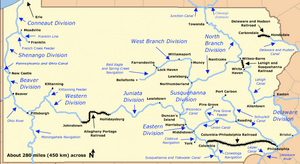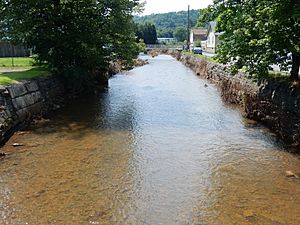Mill Creek and Mine Hill Navigation and Railroad Company facts for kids
The Mill Creek & Mine Hill Navigation and Railroad Co. was an early railroad in Pennsylvania. It started running in the middle of 1829. This made it the second railroad built in Pennsylvania and the third in the entire United States! It was a short line, about four miles long at first. Later, it grew to have about five miles of side tracks. The railroad stretched from Port Carbon, Pennsylvania along the Mill Creek. Its main job was to carry coal from nearby mines. This coal was then taken to Port Carbon. From there, it could be loaded onto the Schuylkill Canal. The canal was like a water highway that took the coal all the way to markets in Philadelphia.
History of the Mill Creek Railroad
The idea for the Mill Creek & Mine Hill Navigation and Railroad Company began with a special law. The Pennsylvania government passed this law on February 7, 1828. This new railroad was planned to use horses to pull its cars. It would run from near the Mill Creek in Port Carbon, Pennsylvania. The tracks would go towards a spot near the Center Turnpike and Broad Mountain, close to St. Clair, Pennsylvania. Its main goal was to move coal from mines along its path. Once the coal reached Port Carbon, it could be moved onto the Schuylkill Canal system. From there, it would travel to Philadelphia and other places.
Work on the railroad started in May 1829. It was a two-mile track with a special width of 40 inches between the rails. By July 4, 1829, the railroad was almost finished. Coal was being moved and put onto the canal even before the railroad was fully done. This made it one of the first commercial railroads in the United States. The railroad used a type of track called "English strap rail." This made it easy for one horse to pull six tons of coal in six cars. The Mill Creek Railroad was the first one to operate in the Southern Anthracite Coal Field. From the day it opened, it carried between 150 to 225 tons of coal every day! When it was finished, the railroad had a four-mile main line and three miles of side tracks.
In 1832, a railroad supporter named George W. Smith described the Mill Creek railroad. He said it was built quickly and cheaply. It was made without an engineer's help, in the very early days of railroads. Over time, it grew to have nine side branches, adding up to five miles of track. In 1831, it carried 30,300 tons of coal. Each load traveled about three miles on average.
Horses continued to power the Mill Creek railroad until 1844. Also, the 40-inch track width stayed the same until then. In 1844, the railroad connected with the Philadelphia and Reading Railroad (P&R). This connection brought new changes. The Mill Creek railroad started using stronger iron T-rails. It also changed its track width to the standard size. The P&R had built a 2.5-mile railroad to Port Carbon. This connected to its main station at Mount Carbon, Pennsylvania. This gave mine owners another way to transport their coal by train.
By 1849, the Mill Creek Railroad was moving a lot of coal. It sent over 100,000 tons to the Schuylkill Canal. It also sent 140,000 tons to the P&R railroad. In 1857, a new law allowed the Mill Creek Railroad to build tracks to the Mahanoy Valley. This area was in the Second Coal Region. However, a different company, the Mahanoy & Broad Mountain Railroad, built that line instead. The P&R then leased and operated this new line. This expansion helped coal from the Mahanoy Valley mines travel south. It went through St. Clair, Pennsylvania to reach the markets where it was sold.



